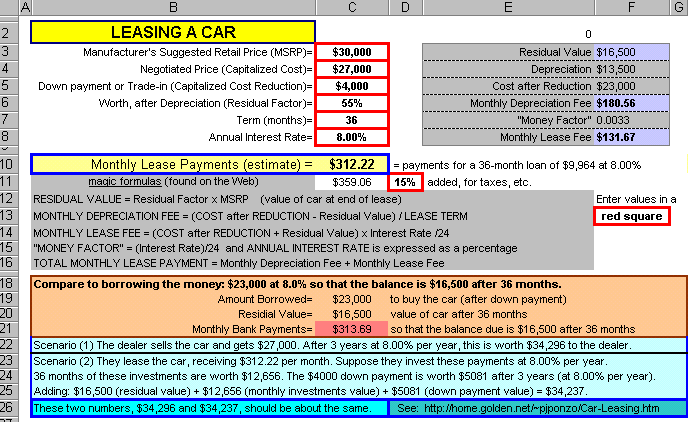| Leasing a Car |
Once upon a time I found a magic formula for the monthly payments, when leasing a car.
See Lease Payments.
I decided to try to make sense of it, so generated an Excel spreadsheet which looks like so:

|
|
You stick new values into the red squares. If you think it might be helpful, you can download the spreadsheet (as a .ZIP'd file): To download the file, RIGHT-click here and Save Target.
I forgot. You also get a chart, like so | 
|
The car dealer can either:
[**] A(1+I)N = D(1+I)N + P{(1+I/12)12N - 1}/(I/12) + R
This allows us to determine the monthly payments $P ... uh .... well, let's simplify first:
We'll use an approximation for items like (1+I)N, namely 1+NI. Then the above equation
becomes:
Notice that 12N monthly payments of $P turn out to be
12PN dollars. No compound interest with these approximations!
Okay, forging ahead, we solve for P like so:
The spreadsheet uses something* like the above formula
... but I wouldn't count on your dealer using the same.
* The spreadsheet, and your dealer, actually uses a
somewhat different formula:
In the spreadsheet, the second "Leasing Fee" term is the average between (A - D)I/12 which
is the monthly interest on the loan, and (R)I/12 which is the monthly interest on the residual value of the
car. Their average is: (A - D + R)I/24 and the funny-factor I/24 is called the "Money Factor" (!)
That gives our final formula:
Okay. In order that the dealer make equal amounts for scenarios (1) and (2), the two final
numbers (after N years) should be equal:
A(1+I)N
I say I% interest rate, but, if the rate were 8% per year,
we'd use I = 0.08 in the following formulas, okay?
D(1+I)N + P{(1+I/12)12N - 1}/(I/12) + R
A(1+NI) = D(1+NI) + P{(1+NI) - 1}/(I/12) + R = D(1+NI) + 12PN + R
P = (A - D - R)/12N + (A - D)I/12
| P = (A - D - R)/12N + (A - D + R)I/24 |
- N is the lease term, in years (so 12N is the number of months).
- $A is the negotiated price of the car (after haggling).
- $D is your trade-in or down payment (which may be $0).
- $R is the residual value of the car: what it's worth after N years.
It's a percentage of the Manufacturer's Suggested Retail Price (MSRP) and MSRP will usually be larger than $A, your price after haggling. - I is some annual interest rate: for 8.5% interest, put I = .085 in the formula.
- (A - D - R)/12N is the Depreciation Fee (so the dealer recovers the depreciation after N months).
- (A - D + R)I/24 is the Leasing Fee (to reflect the fact that the dealer is lending you money).
If we use the magic formula [**] (without the simplications/approximations) we'd get monthly payments of:
| P = (I/12) [(A - D)(1+I)N - R ] / [(1+I/12)12N - 1 ] |
To use this formula, you can try this:
Some observations:
- You must add, to the monthly payments, any taxes (example 15% GST+PST, in Canada)
- The added taxes also apply to the Leasing Fee. (Surprise!)
- There may be freight charges, security deposit, acquisition fee, licence fee, etc.
- You'll have to buy liability insurance, maybe $1 million's worth.
- Normal wear and tear and mileage is assumed, when you return the car after N months ... else you'll pay extra.
- Early termination may be costly.
- The law requires that Capitalized Cost, Capitalized Cost Reduction, Residual Value, Lease Charges, Monthly Payments, and other amounts be clearly spelled out, in a uniform way (which bears little resemblance to English).
Okay, suppose:
- You borrow umpteen dollars from the bank in order to buy a car outright: example $26000 ... the price of a car after trade-in?
- After a certain number of months have passed you want to pay off the balance: example after 36 months ... the length of a lease?
- The balance owed (to the bank) is some prescribed amount: example $15500 ... the value of the car when the lease expires?
- You want to know what your bank payments would be.
| P = [(A-D) (1+I)M/12 - R ] [(1+I)1/12 - 1] / [(1+I)M/12 - 1] |
Use this:
However, if we used that earlier approximation, replacing (1+x)n by 1+nx, then (1+I)1/12 - 1 = I/12

Note: The spreadsheet above has all three formulas.

